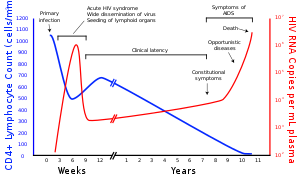Signs and symptoms

Infection with HIV-1 is associated with a progressive decrease of the CD4+ T cell count and an increase in viral load, the level of HIV in the blood. The stage of infection can be determined by measuring the patient's CD4+ T cell count and viral load.
The stages of HIV infection are acute infection (also known as primary infection), latency and AIDS. Acute infection lasts for several weeks and may include symptoms such as fever, lymphadenopathy (swollen lymph nodes), pharyngitis (sore throat), rash, myalgia (muscle pain), malaise, and mouth and esophageal sores. The latency stage involves few or no symptoms and can last anywhere from two weeks to twenty years or more, depending on the individual. AIDS, the final stage of HIV infection, is defined by low CD4+ T cell counts (fewer than 200 per microliter), various opportunistic infections, cancers and other conditions.
No comments:
Post a Comment